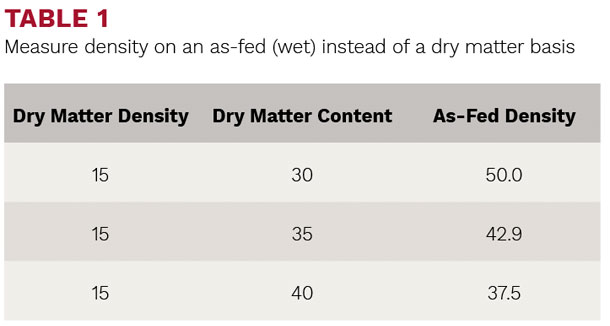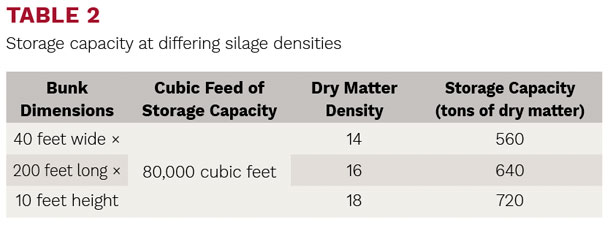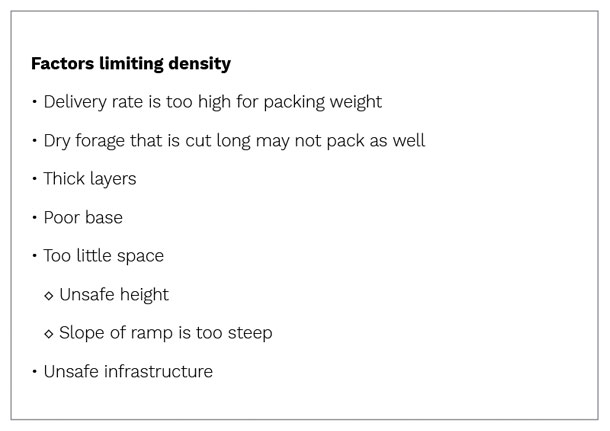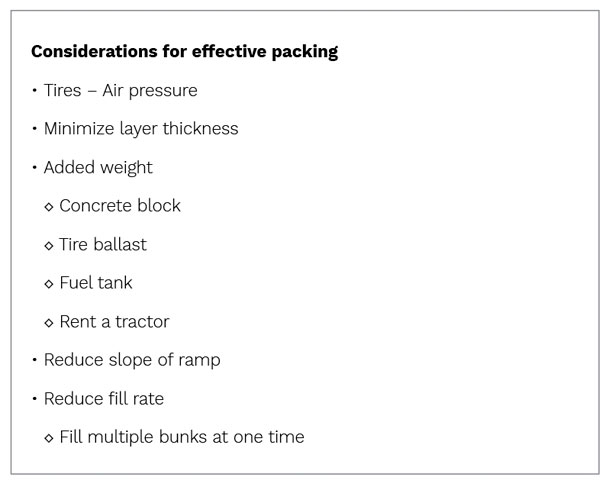Minimize storage loss and feed quality deterioration
Work conducted by Kurt Ruppel in the 1990s established the correlation between silage density and dry matter losses and remains the basis for almost every discussion around silage density. This also established the idea that a dry matter density of 14 to 16 pounds (dry matter) per cubic foot was the minimum needed to keep dry matter losses at acceptable levels. The concept that this density is the minimum acceptable density, and not the target density, is key. There is a strong argument that a density of 18 pounds per cubic foot is a desirable and achievable goal.
More recently researchers at USDA-ARS and University of Wisconsin introduced the concept of measuring density on an as-fed (wet) basis rather than on a dry matter basis. This takes into account the fact that using a dry matter density ignores the role of moisture content. An example of this is shown in Table 1.

In this example we see that silages with different dry matter contents have the same dry matter density but much different as-fed densities, effectively giving a false sense of an acceptable density for a drier feed, when in reality this forage is not packed as well as the wetter feed. Many now reference 45 pounds (as-fed) per cubic foot as the minimum density to work towards, with the argument that a number closer to 50 is both desirable and achievable.
Optimize the footprint of stored feed
The footprint of forage storage on a farm is often a significant investment of resources. This includes the land allotted for storage structures, financial investment, and environmental considerations related to collecting and managing water that collects in the storage area.
With a known volume of storage, the storage capacity at differing silage densities can be calculated. Table 2 provides an example of this.

In this case dry matter density is used to demonstrate the storage capacity in tons of dry matter.
If a farm is considering the addition of new storage structures, taking a hard look at silage density and the ability to significantly increase storage capacity of existing structures, may solve a farm’s storage needs. In one recent scenario a dairy with approximately 800 milking cows was able to increase forage inventory from 9.5 to 14 months without building any new storage. An added benefit that is not taken into consideration in this example is that the increased density will also reduce shrink, thereby further increasing available inventory.
Accurate inventory calculations and management
In the accompanying article “Feed bunk management – Ensuring enough feed for all cows” a key to adequate and consistent forage for the herd is an accurate understanding of forage inventory. Accurate calculations of forage inventory require accurate storage volume measurements and an accurate understanding of overall density. Density can be – by far – the most challenging number to determine. Many efforts from spreadsheet-based models to physical coring of the silage have been used.
Coring the face of a pile is strongly discouraged for safety reasons and only provides a snapshot of the density for the specific area where the sample was taken. While this may be better than a wild guess, if the density in that particular spot, or even multiple spots, was not representative of the entire mass of forage then it could lead to significant errors when calculating available inventory. Some efforts have been made to core from the top of a pile which can address safety concerns, though caution is still needed, but it presents the same challenges in obtaining a value that is representative of the entire forage mass.
The University of Wisconsin has a spreadsheet to calculate average silage density (Making a feed inventory) in a silo that, when accurate data is used to populate the spreadsheet, can provide a very accurate value for average density. Like any calculator, the results are only as accurate as the data entered, so taking time to record the needed inputs during silo filling is key.
The inputs include silo height, silage delivery rate, silage dry matter, layer thickness, packing tractor weight, and the percent of time each tractor is actually packing. An important consideration is that while no tractor is packing 100 percent of the time it is reasonable to use 90 to 95 percent for most dedicated packing tractors. Any tractor that has the primary job of pushing is often only on the pile packing 50 to 60 percent of the time. ![]()


Betsy Hicks is a dairy specialist with Cornell Cooperative Extension SCNY Dairy and Field Crops Team. Email Betsy Hicks.
Joe Lawrence is a dairy forage systems specialist with Cornell PRO-DAIRY. Email Joe Lawrence.
This article appeared in PRO-DAIRY’s The Manager in March 2020. To learn more about Cornell CALS PRO-DAIRY program, visit PRO-DAIRY Cornell CALS.
PRO-DAIRY offers a number of highly rated online courses taught by leaders in the field. In Fall 2019 the forage management course featured topics ranging from crop selection and harvest management to storage management and forage feedout. For more information about PRO-DAIRY online courses, including current offerings, visit PRO-DAIRY Cornell online courses.






